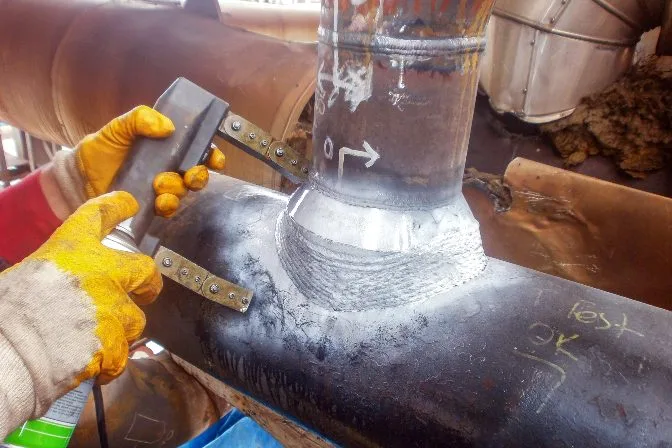A Comprehensive Guide to Understanding Exactly How Welding Inspection Functions: Techniques, Criteria, and Best Practices for Quality Guarantee in Steel Fabrication
Comprehending the details of welding evaluation is crucial for maintaining the stability of metal fabrication. Implementing ideal practices can dramatically improve high quality guarantee actions. The landscape of welding examination is not without its difficulties.
Importance of Welding Assessment
Although welding is an important process in various industries, its integrity straight impacts the safety and performance of elements and structures. Reliable welding assessment is necessary for identifying defects that could jeopardize the quality and resilience of bonded joints. This process ensures adherence to developed specifications and criteria, which are crucial for preserving structural integrity and functional reliability.
Welding inspection serves numerous functions, including verifying that the welding procedure has actually been performed correctly, assessing the top quality of materials utilized, and confirming that the completed product meets regulatory and sector criteria (Houston Welding Inspection). Via rigorous assessment, possible problems such as porosity, splits, and insufficient blend can be discovered early, alleviating and stopping costly repairs safety risks
In addition, regular welding inspections foster self-confidence amongst stakeholders, including designers, customers, and regulative bodies, by demonstrating a dedication to quality control. The relevance of welding inspection can not be overstated; it is essential not only for conformity with lawful requirements but also for improving the total performance of welded structures. Inevitably, a durable welding examination program is a positive procedure that safeguards against failures, guaranteeing the longevity and reliability of bonded components in their designated applications.
Usual Welding Inspection Techniques

Aesthetic inspection is the initial line of protection, enabling inspectors to determine surface area issues such as fractures, undercuts, or incomplete combination. Radiographic testing uses X-rays or gamma rays to reveal internal flaws, making it suitable for intricate welds. Ultrasonic screening uses high-frequency sound waves to identify subsurface defects, offering exact measurements of weld integrity.
Magnetic fragment screening works for ferromagnetic products, highlighting surface and near-surface stoppages when fragments are related to a magnetic area. On the other hand, color penetrant screening uses a fluid color to reveal surface-breaking issues, ensuring that even the smallest flaws are detected.
Each method has its staminas and restrictions, often demanding a mix of methods for detailed assessment - Houston Welding Inspection. By using these evaluation methods, quality control in steel manufacture is achieved, guaranteeing that bonded structures satisfy safety and security and performance criteria
Market Specifications for Welding

The American Welding Culture (AWS) and the American National Specification Institute (ANSI) are two prominent companies that develop welding standards. description AWS D1.1, as an example, describes the needs for welding steel frameworks, while AWS D1.2 concentrates on aluminum. Globally, the ISO 3834 basic addresses high quality demands for blend welding, giving a framework relevant throughout nationwide boundaries.

Best Practices for Top Quality Guarantee
Quality guarantee in welding is extremely important to attaining safe and resilient constructions. Developing a comprehensive top quality administration system (QMS) tailored to the particular welding task is crucial.
Routine training and accreditation of welding workers are important for maintaining a knowledgeable workforce. Constant education and learning on the most up to date welding visit here strategies and modern technologies makes certain that examiners and welders are knowledgeable regarding present requirements and methods.
Additionally, carrying out pre-weld examinations to examine products and devices can protect against problems prior to they happen. Houston Welding Inspection. Throughout the welding procedure, real-time tracking and documents of welding specifications aid recognize incongruities promptly. Post-weld examinations must entail extensive exams utilizing non-destructive screening (NDT) approaches to ensure the stability of the welds
Furthermore, keeping clear interaction amongst employee advertises a culture of high quality. Regular audits and evaluations of the welding process aid identify locations for improvement. By sticking to these best practices, companies can accomplish optimal quality control, ultimately causing enhanced security and efficiency in metal construction tasks.
Challenges in Welding Evaluation
Although welding inspection is vital for making certain structural honesty, it offers a variety of obstacles that can make complex the assessment procedure. One significant obstacle is the irregularity in welding methods and products utilized, which can affect the uniformity of weld quality. Different welders might employ differing methods, leading to inconsistencies that inspectors requirement to assess and identify.
One more challenge entails the detection of flaws. Non-destructive screening (NDT) methods, such as radiographic and ultrasonic screening, can be complicated and require skilled professionals to translate results precisely. False positives or downsides can take place, potentially causing expensive rework or endangered safety and security.
Additionally, the existence of ecological aspects, such as temperature and moisture, can affect the honesty of welds and the effectiveness of assessment techniques. Assessors must likewise navigate the governing landscape, making certain compliance with market standards, which can differ by jurisdiction and like this application.
Verdict
Finally, welding inspection plays an essential function in guaranteeing the honesty and safety of steel manufacture. Employing a range of assessment strategies, adhering to well-known market standards, and carrying out efficient quality monitoring methods jointly enhance the dependability of bonded structures. Despite the challenges encountered in the evaluation procedure, a dedication to constant renovation and adherence to ideal techniques can dramatically boost the quality assurance framework, cultivating better self-confidence amongst stakeholders in the welding market.
Effective welding examination is crucial for determining defects that might jeopardize the high quality and toughness of welded joints.Moreover, constant welding assessments foster self-confidence amongst stakeholders, including designers, customers, and governing bodies, by showing a dedication to quality assurance.The American Welding Society (AWS) and the American National Criteria Institute (ANSI) are 2 noticeable organizations that establish welding criteria. Throughout the welding process, real-time monitoring and documentation of welding parameters help identify disparities right away. Despite the difficulties dealt with in the assessment process, a dedication to continual renovation and adherence to ideal practices can considerably reinforce the quality guarantee framework, promoting better confidence amongst stakeholders in the welding industry.